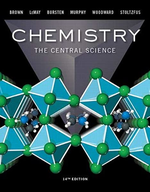?A chemist at a pharmaceutical company is measuring equilibrium constants for reactions
Chapter 15, Problem 15.40(choose chapter or problem)
A chemist at a pharmaceutical company is measuring equilibrium constants for reactions in which drug candidate molecules bind to a protein involved in cancer. The drug molecules bind the protein in a 1:1 ratio to form a drug-protein complex. The protein concentration in aqueous solution at \(25^{\circ} \mathrm{C}\) is \(1.50 \times 10^{-6} \mathrm{M}\). Drug A is introduced into the protein solution at an initial concentration of \(2.00 \times 10^{-6} \mathrm{M}\). Drug B is introduced into a separate, identical protein solution at an initial concentration of \(2.00 \times 10^{-6} \mathrm{M}\). At equilibrium, the drug A-protein solution has an A-protein complex concentration of \(1.00 \times 10^{-6} \mathrm{M}\), and the drug B solution has a B-protein complex concentration of \(1.40 \times 10^{-6} \mathrm{M}\). Calculate the \(K_{c}\) value for the A-protein binding reaction and for the B-protein binding reaction. Assuming that the drug that binds more strongly will be more effective, which drug is the better choice for further research?
Text Transcription:
25^{\circ} C
1.50 X 10-6 M
2.00 X 10-6 M
1.00 X 10-6 M
1.40 X 10-6 M.
K_c
Unfortunately, we don't have that question answered yet. But you can get it answered in just 5 hours by Logging in or Becoming a subscriber.
Becoming a subscriber
Or look for another answer
